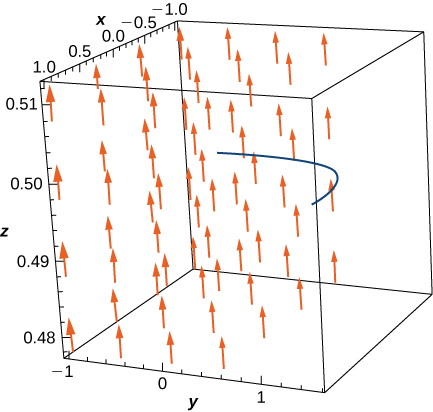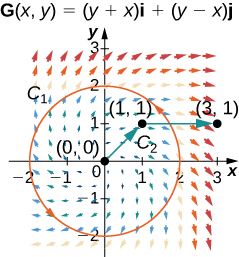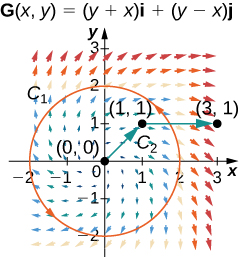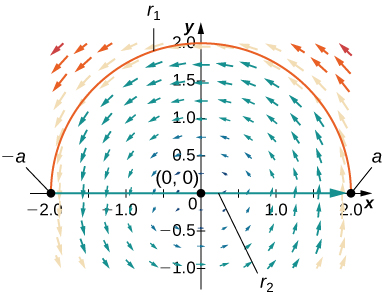9.3E: EXERCISES
( \newcommand{\kernel}{\mathrm{null}\,}\)
Exercise 9.3E.1: True or False?
1. If vector field ⇀F is conservative on the open and connected region D, then line integrals of ⇀F are path independent on D, regardless of the shape of D.
2. The Function r(t)=a+t(b−a), where 0≤t≤1, parameterizes the straight-line segment from a to b.
3. The vector field ⇀F(x,y,z)=(ysinz)ˆi+(xsinz)ˆj+(xycosz)ˆk is conservative.
4. The Vector field ⇀F(x,y,z)=yˆi+(x+z)ˆj−yˆk is conservative.
- Answer
-
1. T, 3. T
Exercise 9.3E.2: Line integral over vector field
5. Justify the Fundamental Theorem of Line Integrals for ∫C⇀F·⇀dr in the case when ⇀F(x,y)=(2x+2y)ˆi+(2x+2y)ˆj and C is a portion of the positively oriented circle x2+y2=25 from (5,0) to (3,4).
- Answer
-
∫C⇀F·⇀dr=24
6. [T] Find ∫C⇀F·⇀dr, where ⇀F(x,y)=(yexy+cos(x))ˆi+(xexy+1y2+1)ˆj and C is a portion of curve
y=sinx from x=0 to x=π2.
7. [T] Evaluate line integral ∫C⇀F·⇀dr, where ⇀F(x,y)=(exsiny−y)ˆi+(excosy−x−2)ˆj, and C is the path given by
r(t)=(t3sinπt2)ˆi−(π2cos(πt2+π2))ˆj for 0≤t≤1.

- Answer
-
e−3π2
Exercise 9.3E.3
For the following exercises, determine whether the vector field is conservative and, if it is, find the potential function.
8. ⇀F(x,y)=2xy3ˆi+3y2x2ˆj
9. ⇀F(x,y)=(−y+exsiny)ˆi+[(x+2)excosy]ˆj
- Answer
-
Not conservative
10. ⇀F(x,y)=(e2xsiny)ˆi+[e2xcosy]ˆj
11. ⇀F(x,y)=(6x+5y)ˆi+(5x+4y)ˆj
- Answer
-
Conservative, ⇀F(x,y)=3x2+5xy+2y2
12. ⇀F(x,y)=[2xcos(y)−ycos(x)]ˆi+[−x2sin(y)−sin(x)]ˆj
13. ⇀F(x,y)=[yex+sin(y)]ˆi+[ex+xcos(y)]ˆj
- Answer
-
Conservative, ⇀F(x,y)=yex+xsin(y)
Exercise 9.3E.4
For the following exercises, evaluate the line integrals using the Fundamental Theorem of Line Integrals.
14. ∫C(yˆi+xˆj)·dr, whereC is any path from (0,0) to (2,4)
15. ∫C(2ydx+2xdy), where C is the line segment from (0, 0) to (4, 4)
- Answer
-
∫C(2ydx+2xdy)=32
16. [T] ∫C[arctanyx−xyx2+y2]dx+[x2x2+y2+e−y(1−y)]dy, where C is any smooth curve from (1,1) to (−1,2)
17. Find the conservative vector field for the potential function
f(x,y)=5x2+3xy+10y2.
- Answer
-
⇀F(x,y)=(10x+3y)i+(3x+10y)j
Exercise 9.3E.5
For the following exercises, determine whether the vector field is conservative and, if so, find a potential function.
18. ⇀F(x,y)=(12xy)ˆi+6(x2+y2)ˆj
19. ⇀F(x,y)=(excosy)ˆi+6(exsiny)ˆj
- Answer
-
F is not conservative.
20. ⇀F(x,y)=(2xyex2y)ˆi+6(x2ex2y)ˆj
21. F(x,y,z)=(yez)ˆi+(xez)ˆj+(xyez)ˆk
- Answer
-
F is conservative and a potential function is f(x,y,z)=xyez.
22. F(x,y,z)=(siny)ˆi−(xcosy)ˆj+ˆk
23. F(x,y,z)=(1y)ˆi+(xy2)ˆj+(2z−1)ˆk
- Answer
-
F is conservative and a potential function is f(x,y,z)=z2−z−xy.
24. F(x,y,z)=3z2ˆi−cosyˆj+2xzˆk
25. F(x,y,z)=(2xy)ˆi+(x2+2yz)ˆj+y2ˆk
- Answer
-
F is conservative and a potential function is f(x,y,z)=x2y+y2z.
Exercise 9.3E.6
For the following exercises, determine whether the given vector field is conservative and find a potential function.
26. ⇀F(x,y)=(excosy)ˆi+6(exsiny)ˆj
27. ⇀F(x,y)=(2xyex2y)ˆi+6(x2ex2y)ˆj
- Answer
-
⇀F is conservative and a potential function is f(x,y)=ex2y
Exercise 9.3E.7
For the following exercises, evaluate the integral using the Fundamental Theorem of Line Integrals.
28. Evaluate ∫C⇀∇f·⇀dr, where f(x,y,z)=cos(πx)+sin(πy)−xyz and C is any path that starts at (1,12,2) and ends at (2,1,−1).
29. [T] Evaluate ∫C⇀∇f·⇀dr, where f(x,y)=xy+ex and C is a straight line from (0,0) to (2,1).
- Answer
-
Solution: ∫C⇀F·⇀dr=e2+1
30. [T] Evaluate ∫C⇀∇f·⇀dr, where f(x,y)=x2y−x and C is any path in a plane from (1, 2) to (3, 2).
31. Evaluate ∫C⇀∇f·⇀dr, where f(x,y,z)=xyz2−yz and C has initial point (1, 2,3) and terminal point (3, 5,1).
- Answer
-
∫C⇀F·⇀dr=−2
Exercise 9.3E.8
For the following exercises, let ⇀F(x,y)=2xy2ˆi+(2yx2+2y)ˆj and G(x,y)=(y+x)ˆi+(y−x)ˆj, and let C1 be the curve consisting of the circle of radius 2, centered at the origin and oriented counterclockwise, and C2 be the curve consisting of a line segment from (0, 0) to (1, 1) followed by a line segment from (1, 1) to (3, 1).


32. Calculate the line integral of F over C1.
33. Calculate the line integral of G over C1.
- Answer
-
Solution: ∮C1G·dr=−8π
34. Calculate the line integral of F over C2.
35. Calculate the line integral of G over C2.
- Answer
-
Solution: ∮C2F·dr=7
36. [T] Let F(x,y,z)=x2ˆi+zsin(yz)j+ysin(yz)k. Calculate ∮CF·dr, where C is a path from A=(0,0,1) to B=(3,1,2).
37. [T] Find line integral ∮CF·dr of vector field F(x,y,z)=3x2zˆi+z2ˆj+(x3+2yz)ˆk along curve C parameterized by r(t)=(lntln2)ˆi+t3/2ˆj+tcos(πt)ˆk,1≤t≤4.
- Answer
-
Solution: ∫C⇀F·⇀dr=150
Exercise 9.3E.9
For the following exercises, show that the following vector fields are conservative. Calculate ∫C⇀F·⇀dr for the given curve.
38. ⇀F=(xy2+3x2y)ˆi+(x+y)x2ˆj; C is the curve consisting of line segments from (1,1)to (0,2) to (3,0).
39. ⇀F=2xy2+1ˆi−2y(x2+1)(y2+1)2ˆj; C is parameterized by x=t3−1,y=t6−t,0≤t≤1.
- Answer
-
Solution: ∫C⇀F·⇀dr=−1
40. [T] ⇀F=[cos(xy2)−xy2sin(xy2)]ˆi−2x2ysin(xy2)ˆj; C is curve (et,et+1),−1≤t≤0.
Exercise 9.3E.10
41. The mass of Earth is approximately 6×1027g, and that of the Sun is 330,000 times as much. The gravitational constant is 6.7×10−8cm3/s2·g. The distance of Earth from the Sun is about 1.5×1012cm. Compute, approximately, the work necessary to increase the distance of Earth from the Sun by 1 cm.
Solution: 4×1031erg
42. [T] Let ⇀F=(x,y,z)=(exsiny)ˆi+(excosy)ˆj+z2ˆk. Evaluate the integral ∫C⇀F·⇀ds,where C(t)=(√t,t3,e√t),0≤t≤1.
43. [T] Let c:[1,2]→ℝ^2 be given by x=e^{t−1},y=sin(\dfrac{π}{t}). Use a computer to compute the integral \int _CF·ds=\int _C2xcosydx−x^2sinydy, where \vecs{F}=(2xcosy)i−(x^2siny)j.
- Answer
-
Solution: \int _CF·ds=0.4687
44. [T] Use a computer algebra system to find the mass of a wire that lies along curve r(t)=(t^2−1)\, \hat{ \mathbf j}+2t\, \hat{ \mathbf k},0≤t≤1, if the density is \dfrac{3}{2}t.
45. Find the circulation and flux of field \vecs{F}=−y\, \hat{ \mathbf i}+x\, \hat{ \mathbf k} around and across the closed semicircular path that consists of semicircular arch r_1(t)=(acost)\, \hat{ \mathbf i}+(asint)\, \hat{ \mathbf j},0≤t≤π, followed by line segment r_2(t)=t\, \hat{ \mathbf i},−a≤t≤a.

- Answer
-
Solution: circulation=πa^2 and flux=0
46. Compute \int _C cosxcosydx−sinxsinydy, where C(t)=(t,t^2),0≤t≤1.
47. Complete the proof of Note by showing that f_y=Q(x,y).


